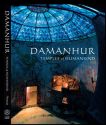Exploring this book is a delight, with jewel-like bursts of color surprising the viewer down every passageway and excavated chamber. Like ineffable experiences of the Godhead, so too the impact of the art and architecture that make up the Temples of Humankind can not be adequately expressed in the words of any review. Quite simply, Damanhur: Temples of Humankind belongs in every entheoart lover’s library. [ read more ]
[A]n exhaustive overview detailing the botany, geography, history, mythology, archeology, chemistry, and pharmacology of this widely used entheogen. ...The book is considerably enhanced by 59 high quality black & white plates, 41 of which contain photographs. Many of the remaining plates are attractive pen-and-ink drawings by Donna Torres. ...All in all, this is as solid a reference book as I can possibly imagine, and one which should grace the shelves of every entheophile’s library. [ read more ]
Charles Hayes has brought together a mind-blowing collection of first-person psychonautical voyages in his book Tripping: An Anthology of True-life Psychedelic Adventures. Hayes is a gifted writer whose edgy style accurately conveys the various nuances of the psychedelic experience without being overblown. The book’s introduction provides the appropriate historical nods, while showcasing Hayes’ exhaustive knowledge and understanding of the topic, and exposing the cutting edge of current underground drug culture. [ read more ]
Robert Forte has compiled an excellent selection of “appreciations, castigations, and reminiscences” as a festschrift to Dr. Timothy Leary. Along the way we hear tales from John Beresford, William S. Burroughs, Ram Dass, Allen Ginsberg, Albert Hofmann, Aldous Huxley , Ken Kesey, Terence McKenna, Claudio Naranjo, Thomas Riedlinger, Winona Ryder, Myron Stolaroff, Hunter S. Thompson, Andrew Weil, Robert Anton Wilson, Rosemary Woodruff, and many others. An impressive cast of characters to be sure. [ read more ]
It may be a rare thing for a second edition of a book to warrant its own review, but such is definitely the case with the new edition of the Schultes’ and Hofmann’s 1979 classic Plants of the Gods. Any and all criticism of this book should be viewed as minor, as it is truly a marvelous work. Rätsch has taken a great book and made it better. Especially if you own the first edition, you owe it to yourself to pick up this revamp. It is visual delight, a joy to read cover-to-cover, and it will no doubt be revisited repeatedly for years to come. [ read more ]
It is heartening to see Grey’s recent stylistic development being applied in both new and familiar ways; the mark of a good artist is one who isn’t afraid to reinvent himself from time to time. Clearly Grey has his chops down, and I am pleased to see the new directions that he is taking, while retaining the spiritual focus that causes his art to rise above the nihilist, post-modern abstractions that litter the art community like so many disturbing—yet dull—abortions. [ read more ]
Metzner is to be commended for putting together a solid collection of subjective and objective information that illuminates the potential healing quality of ayahuasca. The stories of personal growth are compelling, and the scientific evidence presented speaks to the relative safety of ayahuasca when properly consumed. While there are sure to be a multitude of books published on the topic in years to come, Ayahuasca should stand the test of time as an historically significant contribution on contemporary psychonautical therapy. [ read more ]
Jonathan Ott’s latest book kicks off with a poem. In reviewing this, it would be unfair to both the reader and to Mr. Ott, if I didn’t make it clear that—in general—I am not a fan of poetry. With that noted, I can say that I almost wasn’t able to read “Phytomphalos” in its entirety. Ott’s poem is heavily inspired ... [ read more ]
My first impression of this book was the smell of its leather cover—gorgeous, and quite appropriate that a book on snuffs would engage the reader in such a manner. Indeed, the slipcase, the binding, the luxurious paper (which contributed its own crisp smell), the line drawings by Elmer W. Smith, the excellent typography, and even a woven burgundy place-holding ribbon, ... [ read more ]










